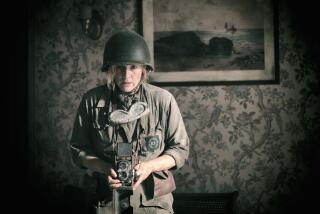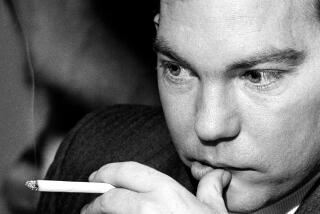Did ‘American Sniper’ miss an important mark?
- Share via
The most chilling moment in “American Sniper” does not appear on film. The movie, directed by Clint Eastwood, is a portrait of Chris Kyle, who served four tours in Iraq and became the most lethal sniper in U.S. military history. But Kyle’s death did not come at the hands of the enemy. He was killed at a shooting range in Texas, allegedly by a troubled 25-year-old Marine who had also fought in the Middle East.
The combat scenes in the Academy Award-nominated movie bristle with authenticity, but the film ultimately hedges, preferring Kyle’s heroics over the irony of his fate. The omission is a testament to the emotional and psychological echoes from Iraq and Afghanistan, two of the longest wars in U.S. history. America rushed into those conflicts and turned ambivalent, even as its soldiers, most from low- and working-class households, endured multiple tours of duty and uncomfortable stares from their countrymen.
Kyle was a U.S. Navy SEAL and a victim of the battlefield and the home front. Bewildered on their return, many veterans with lost limbs and damaged minds still drift on antidepressants and desperation. Kyle had his demons too. But Hollywood is often more partial to myth than discomfiting truths and the lasting effects war has on the nation and its soldiers. That’s not to mention the tens of thousands of Iraqis and Afghans — militants and innocents — who have died and who in films such as 2013’s “Lone Survivor” amount to ill-defined cutouts.
“For two hours, the soldiers in ‘Lone Survivor’ are killing the Taliban, and not once are you given any sense that the Taliban are anything more than fodder,” said Steven Jay Rubin, author of “Combat Films: American Realism 1945-2010.” “We don’t have the time to get into the head of the enemy. The studios are in it for the money and their stars. They’re not into complexities.”
Marketing a film for a studio is much like marketing a war for the White House: Appeal to Middle America with heroics, righteousness and bravado; gloss over gray areas, avoid too many details. By highlighting brave soldiers, Rubin said, recent movies have tapped into the country’s pro-military leanings.
Despite that strategy, a number of movies, including “The Hurt Locker” (2008), “The Valley of Elah” (2007) and “The Messenger” (2009), have explored the psychological wounds and unsettled detritus of these wars. But filmmakers, like the nation, struggle with the perplexing narratives that have bedeviled American politics while hundreds of thousands of soldiers have been treated for brain injuries, amputations, trauma and other afflictions.
“I can think of no better name than no man’s land to describe the physical and emotional landscape in which so many soldiers I know dwell,” Elizabeth D. Samet, a literature professor at West Point, writes in her new book, “No Man’s Land: Preparing for War and Peace in Post-9/11 America.” “The image of no man’s land also reflects the national psyche itself, gripped alternately by paroxysms of sentimentality and bouts of convenient amnesia for more than a decade of war.”
Memoirs and novels by former soldiers, such as Phil Klay, whose short-story collection, “Redeployment,” won last year’s National Book Award, have indelibly captured what the conflicts have wrought. Despite its much-talked-about renaissance, television, with a few exceptions such as HBO’s “Generation Kill,” has largely ignored the wars’ existential questions. The furor between conservatives and liberals over “American Sniper” indicates that the political fault lines drawn by the wars remain deep and spark impassioned interest.
Producers don’t relish taking sides or pushing agendas, dangers that could alienate certain audiences. Bradley Cooper, whose portrayal of Kyle earned him an Academy Award nomination for lead actor, said the aim of “American Sniper” was to be as “specific as possible about this guy and not make a comment about anything else. That’s for people to do who are watching the movie. I’m not saying this is a pro-war movie or an antiwar movie or a war movie, even. It’s a character study.”
The issues aren’t academic. U.S. forces withdrew from Iraq in 2011, but Washington has sent back about 2,000 military advisors to battle the Islamic State, or ISIS. About 10,000 American troops remain in Afghanistan as the Taliban have increased attacks in the provinces. At an estimated cost of as much as $6 trillion and with more than 6,800 U.S. soldiers killed, the conflicts have not brought victory but instead have left a lingering sense of defeat papered over by euphemisms and the parsing of pundits.
World War II
Back almost to its inception, film has been attracted to the high drama of battle, both its jingoistic and heart-rending aspects. Many movies about World War II, which had clearly defined enemies and few gray areas, played as patriotic paeans, including “Bataan” (1943). But director William Wyler’s “The Best Years of Our Lives” (1946) examined the pain of soldiers returning home and adjusting to civilian life. It was a sobering snapshot of an era, exposing the frailties and consequences of battle and the difficulties of re-invention.
The Vietnam War produced a number of surreal films — “Apocalypse Now” (1979) and “Full Metal Jacket” (1987) — that spoke to national disillusionment arising from that conflict. “The Deer Hunter” (1978) and Oliver Stone’s “Platoon” (1986) revealed the moral choices and humanity of soldiers who had been maligned by much of the 1960s antiwar movement as baby killers and war criminals. The best of these came years after the war’s passions had cooled.
The trajectory of American attitudes toward Afghanistan and Iraq followed a World War II-type fervor before morphing into Vietnam-like distress. Propelled by fears of terrorism and false intelligence, the country swept into both wars with purpose. But the resolve faded as the conflicts ground on and the volunteer soldiers, most of whom were from lower economic classes, had little connection to the politics and business interests that run the country.
“World War II was a collective experience for the whole country,” Rubin said. “But today’s wars don’t have that national involvement. There’s no draft. They don’t affect everyone.”
Many former soldiers have questions about the policies that drew them onto desert battlefields even after revelations that Saddam Hussein possessed no weapons of mass destruction and that the U.S. presence in Iraq had in fact multiplied the number of terrorists arrayed against American forces.
“For me it was a mix of anger, sadness and frustration,” said Kevin Powers, an Iraqi veteran whose novel about soldiers, “The Yellow Birds,” won the 2013 PEN/Hemingway Award. “I have to imagine most people now recognize that it [the war] had been a mistake. The ambivalence around it was really a reluctance to wrestle with that choice.” He added that many Americans feel like: “I don’t want to deal with my culpability as a citizen.”
“I do wonder sometimes,” said Powers, who served as a machine gunner in 2004 and 2005, “if we’re not kind of falling into a habit of mythmaking and validation.” He noted that one of the most realistic scenes he has seen in an Iraq war film was in “The Hurt Locker,” when the bomb demolition expert played by Jeremy Renner comes home and finds himself bewildered as he walks through the aisles of a supermarket. It showed “the foreignness, the alienation and the confusion of when you return,” he said.
Despite winning the Academy Award for best picture, “The Hurt Locker,”directed by Kathryn Bigelow, grossed a modest $17 million at the domestic box office. Other nuanced movies about the wars also didn’t sell many tickets at home. “The Messenger,” the story of two soldiers in a bereavement unit, and “In the Valley of Elah,” starring Tommy Lee Jones as a father investigating the stateside murder of his Iraqi-vet son, each grossed significantly less.
Finding an audience
Films concentrating on bravado and heroics tend to find a receptive audience. “Lone Survivor,” starring Mark Wahlberg and based on the true story of U.S. Navy SEALs pinned down by the Taliban during a counterinsurgency mission in Afghanistan, grossed $125 million. Based on Kyle’s autobiography, “American Sniper,” which is nominated for an Academy Award for best picture and recently opened nationwide, has grossed more than $200 million, surpassing the predictions of many box-office watchers.
Studies show that the public has a more extreme view of “veterans based on what they see on film or television,” said Chris Marvin, executive director of Got Your 6, a group seeking to improve how former soldiers are portrayed in the media. “They are heroes on one end of the spectrum or broken veterans on the other end of the spectrum ... but veterans a lot of the time are everyday people.”
“American Sniper” captures the mundaneness and cruelty of war, of fleeting firefights and hours spent hunkering in the dust. Cooper’s depiction of Kyle is a man of exactitude, an assassin who can kill the enemy from a mile away. He faces harrowing moral choices, including whether to shoot a boy who is carrying a rocket-propelled grenade. But he is unequivocating in his mission — to kill the enemy (he calls them savages) before they kill his fellow soldiers.
The film is less revealing when Kyle returns to his wife, Taya, and their children in Texas. He is aloof and adrift; he flinches at the sound of a lawnmower and attacks the family dog. Yet those moments aren’t as layered or compelling as the scenes in Iraq. Kyle was more troubled and flawed than he is portrayed and at times he was possibly detached from reality, including an unsubstantiated 2009 claim that he shot two would-be carjackers at a gas station. Police and prosecutors reported no details of such an incident.
Last year, former Minnesota Gov. Jesse Ventura, a Navy veteran, won a $1.8-million civil suit against Kyle’s estate for a passage in Kyle’s autobiography that stated the sniper punched a man he later identified as Ventura in a bar in 2006. Kyle had alleged that Ventura had made derogatory comments about the military. Ventura argued that the incident was fabricated.
The movie also reduces Eddie Ray Routh, a former Marine corporal charged with killing Kyle and another man at a gun range in 2013, to a cameo. Routh’s family has said he suffered from post-traumatic stress disorder and had been released from a veterans hospital in Dallas days before the alleged incident. Kyle had wanted to help Routh and, as he did with a number of vets, suggested they go target shooting.
Routh appears at the end of the film, standing near Kyle’s pickup. He is on screen for less than a minute before the film ends. There is no scene depicting Kyle’s death. (Routh’s murder trial is expected to begin in February.)
“I considered ending the film at the shooting range,” Eastwood told The Times in December. “But that would have shifted the focus to his death and made it a different movie. We were telling the story of Chris Kyle’s life and wanted to keep the focus there.”
That’s a fair artistic decision. But Kyle offered a profound opportunity. He was a perfect metaphor for the toll of a war that has cost as much pain on the home front as it has on the battlefield. To concentrate on his heroics while not exploring more deeply the darker elements of his civilian life and death is like leaving a photograph partly exposed.
Fleishman covered the Iraq War for The Times.
Staff writer Saba Hamedy contributed to this report.
More to Read
Only good movies
Get the Indie Focus newsletter, Mark Olsen's weekly guide to the world of cinema.
You may occasionally receive promotional content from the Los Angeles Times.











